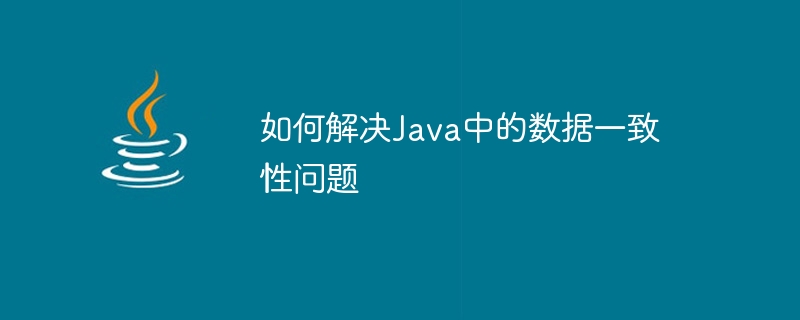如何解決Java中的資料一致性問題

如何解決Java中的資料一致性問題,需要具體程式碼範例
在Java開發過程中,資料一致性問題是常見的難題。資料一致性問題指的是多個執行緒或分散式系統在並發環境下對共享資料進行操作時,由於執行順序的不確定性,可能導致資料的不一致性。這種不一致性可能會導致業務邏輯錯誤、系統崩潰等嚴重後果。為了解決這個問題,我們需要採取一些措施來確保資料的一致性。
下面將介紹幾種常用的解決方案,並給出對應的程式碼範例:
- 使用synchronized關鍵字實作資料同步
Java中的synchronized關鍵字可用於為方法或程式碼區塊加鎖,保證同一時間只有一個執行緒可以存取被鎖定的資源,從而保證資料的一致性。
範例程式碼如下:
public class DataConsistencyExample {
private int count = 0;
public synchronized void increment() {
count++;
}
public static void main(String[] args) throws InterruptedException {
DataConsistencyExample example = new DataConsistencyExample();
// 创建多个线程同时执行increment方法
Thread thread1 = new Thread(() -> {
for (int i = 0; i < 1000; i++) {
example.increment();
}
});
Thread thread2 = new Thread(() -> {
for (int i = 0; i < 1000; i++) {
example.increment();
}
});
// 启动线程
thread1.start();
thread2.start();
// 等待线程执行完毕
thread1.join();
thread2.join();
// 输出结果
System.out.println(example.count);
}
}在上述範例中,我們使用synchronized關鍵字修飾了increment方法,保證了多執行緒對count變數的存取是同步的,從而保證了數據的一致性。
- 使用ReentrantLock實作資料同步
除了synchronized關鍵字外,我們還可以使用Java.util.concurrent套件中的ReentrantLock類別來實現資料同步。 ReentrantLock是一個可重入的互斥鎖,可以取代synchronized關鍵字來控制對共享資源的存取。
範例程式碼如下:
public class DataConsistencyExample {
private int count = 0;
private ReentrantLock lock = new ReentrantLock();
public void increment() {
lock.lock();
try {
count++;
} finally {
lock.unlock();
}
}
public static void main(String[] args) throws InterruptedException {
DataConsistencyExample example = new DataConsistencyExample();
// 创建多个线程同时执行increment方法
Thread thread1 = new Thread(() -> {
for (int i = 0; i < 1000; i++) {
example.increment();
}
});
Thread thread2 = new Thread(() -> {
for (int i = 0; i < 1000; i++) {
example.increment();
}
});
// 启动线程
thread1.start();
thread2.start();
// 等待线程执行完毕
thread1.join();
thread2.join();
// 输出结果
System.out.println(example.count);
}
}在上述範例中,我們使用ReentrantLock類別來取代了synchronized關鍵字,透過呼叫lock.lock()和lock .unlock()方法來控制對共享資源的存取。
- 使用原子類保證資料的一致性
Java.util.concurrent.atomic套件中提供了一些原子類,如AtomicInteger、AtomicLong等,它們可以保證對共享變數的操作是原子性的,從而避免了資料一致性問題。
範例程式碼如下:
public class DataConsistencyExample {
private AtomicInteger count = new AtomicInteger(0);
public void increment() {
count.incrementAndGet();
}
public static void main(String[] args) throws InterruptedException {
DataConsistencyExample example = new DataConsistencyExample();
// 创建多个线程同时执行increment方法
Thread thread1 = new Thread(() -> {
for (int i = 0; i < 1000; i++) {
example.increment();
}
});
Thread thread2 = new Thread(() -> {
for (int i = 0; i < 1000; i++) {
example.increment();
}
});
// 启动线程
thread1.start();
thread2.start();
// 等待线程执行完毕
thread1.join();
thread2.join();
// 输出结果
System.out.println(example.count);
}
}上述範例中,我們使用AtomicInteger類別來定義count變量,透過呼叫incrementAndGet方法來實作對count變數的原子遞增操作,從而保證了數據的一致性。
綜上所述,我們可以透過使用synchronized關鍵字、ReentrantLock類別或原子類別等措施來解決Java中的資料一致性問題。具體使用哪種方式取決於實際需求和場景,開發者需要根據具體情況做出選擇。
以上是如何解決Java中的資料一致性問題的詳細內容。更多資訊請關注PHP中文網其他相關文章!

熱AI工具

Undresser.AI Undress
人工智慧驅動的應用程序,用於創建逼真的裸體照片

AI Clothes Remover
用於從照片中去除衣服的線上人工智慧工具。

Undress AI Tool
免費脫衣圖片

Clothoff.io
AI脫衣器

AI Hentai Generator
免費產生 AI 無盡。

熱門文章

熱工具

記事本++7.3.1
好用且免費的程式碼編輯器

SublimeText3漢化版
中文版,非常好用

禪工作室 13.0.1
強大的PHP整合開發環境

Dreamweaver CS6
視覺化網頁開發工具

SublimeText3 Mac版
神級程式碼編輯軟體(SublimeText3)
 2025年的前4個JavaScript框架:React,Angular,Vue,Svelte
Mar 07, 2025 pm 06:09 PM
2025年的前4個JavaScript框架:React,Angular,Vue,Svelte
Mar 07, 2025 pm 06:09 PM
2025年的前4個JavaScript框架:React,Angular,Vue,Svelte
 如何使用咖啡因或Guava Cache等庫在Java應用程序中實現多層緩存?
Mar 17, 2025 pm 05:44 PM
如何使用咖啡因或Guava Cache等庫在Java應用程序中實現多層緩存?
Mar 17, 2025 pm 05:44 PM
如何使用咖啡因或Guava Cache等庫在Java應用程序中實現多層緩存?
 Spring Boot Snakeyaml 2.0 CVE-2022-1471問題已修復
Mar 07, 2025 pm 05:52 PM
Spring Boot Snakeyaml 2.0 CVE-2022-1471問題已修復
Mar 07, 2025 pm 05:52 PM
Spring Boot Snakeyaml 2.0 CVE-2022-1471問題已修復
 如何將JPA(Java持久性API)用於具有高級功能(例如緩存和懶惰加載)的對象相關映射?
Mar 17, 2025 pm 05:43 PM
如何將JPA(Java持久性API)用於具有高級功能(例如緩存和懶惰加載)的對象相關映射?
Mar 17, 2025 pm 05:43 PM
如何將JPA(Java持久性API)用於具有高級功能(例如緩存和懶惰加載)的對象相關映射?
 如何將Maven或Gradle用於高級Java項目管理,構建自動化和依賴性解決方案?
Mar 17, 2025 pm 05:46 PM
如何將Maven或Gradle用於高級Java項目管理,構建自動化和依賴性解決方案?
Mar 17, 2025 pm 05:46 PM
如何將Maven或Gradle用於高級Java項目管理,構建自動化和依賴性解決方案?









